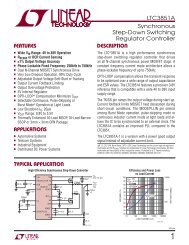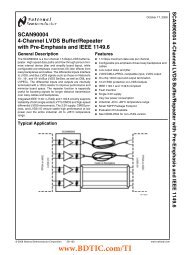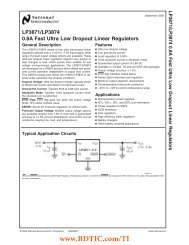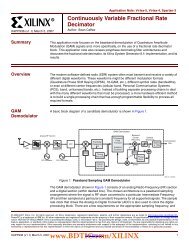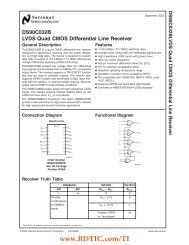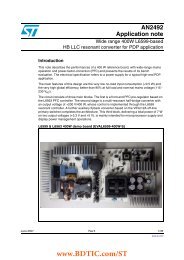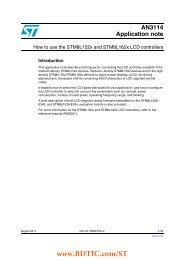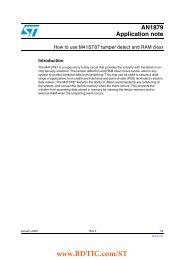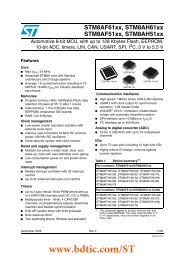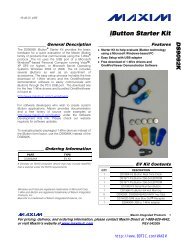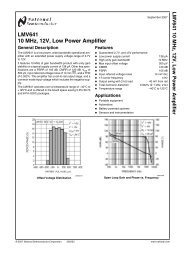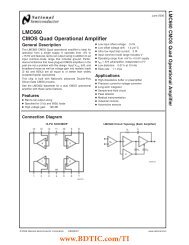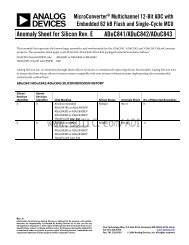Xilinx XAPP713 Virtex-4 RocketIO Bit-Error Rate Tester, application ...
Xilinx XAPP713 Virtex-4 RocketIO Bit-Error Rate Tester, application ...
Xilinx XAPP713 Virtex-4 RocketIO Bit-Error Rate Tester, application ...
- No tags were found...
You also want an ePaper? Increase the reach of your titles
YUMPU automatically turns print PDFs into web optimized ePapers that Google loves.
Single-Channel XBERT ModuleRSingle-ChannelXBERT ModuleThe single-channel XBERT is a self-contained module providing all necessary BER testfunctions, independent of the PPC405 subsystem. The single-channel XBERT module is amodular design that can be scaled to multiple channels in the FPGA fabric.Figure 6 shows the block diagram of a single-channel XBERT module implemented in theXBERT reference design. A single-channel XBERT module consists of the following maincomponents:• An MGT tile containing two <strong>Virtex</strong>-4 <strong>RocketIO</strong> MGTs (MGTA and MGTB)Both MGTs share the buffered TXUSRCLK2; therefore they must operate at the same TXdata rate.• Two pattern checkers connecting to two MGTs• One pattern generator shared by two MGTs• One clock/reset module generating two independent RXUSRCLK2 for two MGTsThis module contains two global clock buffers (BUFGs) for buffering RXRECCLK1 fromeach MGT and generating RXUSRCLK2. It also generates clock status outputs(dcm_locked_rx) by detecting RXRECCLK1.• Two comma align control modules connecting to two MGTsThese modules are enabled when comma_align_enable is High. Each module attaches toone MGT for toggling the ENPCOMMAALIGN and ENMCOMMAALIGN ports. It indicatesaligned and disables comma alignment on the MGT once the pattern checker indicateslink-up and detects seven idles in the incoming data.• Two bit error counters for two pattern checkersEach counter aggregates the number of erroneous bits detected in the pattern checker intoa 32-bit value. Each counter is updated at every clock cycle and can be cleared by adedicated reset (ber_cnt_reset).The XBERT reference design uses the DSP48 block in the <strong>Virtex</strong>-4 FPGA as the 32-bitcounter in order to improve timing performance and save fabric resources. The user canremove the use of DSP48 by asserting a compile option.• Two RX word counters for two MGTsEach counter is a free-running 32-bit counter on the RXUSRCLK2 domain that produces atotal number of received words. This counter only increases when the MGT RX PLL islocked. This number is necessary for calculating a BER. The user can issue a dedicatedreset (ber_cnt_reset) to clear each counter.• Two shallow asynchronous FIFOs for two MGTsThese FIFOs provide the fabric loopback function that reflects the incoming data back tothe transmission. Each FIFO is a 16-deep asynchronous FIFO constructed using the dualportdistributed RAM. The write port is clocked on RXUSRCLK2, and the read port isclocked on TXUSRCLK2. These buffers can handle phase differences (but not frequencydifferences) between two clocks. When fabric loopback is enabled, it requires that theincoming data be frequency-locked to the local reference clock, as in a synchronousoperation.• Two Calibration Blocks for two MGTsThe calibration block is attached to each MGT to perform calibration and monitoringfunctions. The default calibration block used in this reference design is v1.4.1.• One ChipScope Pro ILA coreThis core is clocked on the RXUSRCLK2 signal of either MGTA or MGTB. Data from bothMGTs and associated internal logic are multiplexed by the mgt_sel input before being fedinto the ILA core so that the selected MGT data can be displayed on ChipScope ProAnalyzer.www.BDTIC.com/XILINX<strong>XAPP713</strong> (v1.1) April 18, 2007 www.xilinx.com 15



